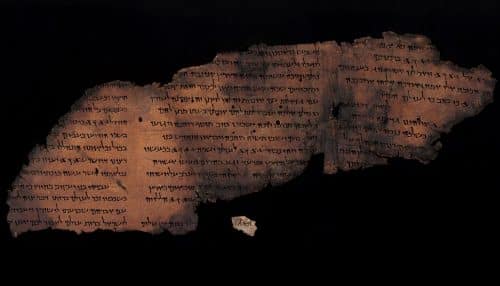An Antiquities Authority researcher examined fragments of scrolls with the advanced photographic means in the laboratories of the Judean Desert Scrolls Unit, and was thrilled to discover letters that the eye cannot see * The fragments, which were presented today as part of the 70th international conference on the buried scrolls: "In the desert a path was made", provide new information about one of the most important archaeological discoveries of 20th century * The conference is being held at the initiative of the Orion Center at the Hebrew University, the Antiquities Authority, the Israel Museum, the University of Vienna and New York University

Discovery: Advanced photographic technology, developed especially for scrolls from the Judean Desert and used by the scroll laboratories at the Antiquities Authority, revealed writing marks that could not be seen until now.
In the 50s, in the caves near Qumran, researchers and Bedouins discovered tens of thousands of pieces of parchment and papyrus that were written 20 years ago, and belonged to about 2,000 manuscripts. Due to their size and poor state of preservation, some of these small fragments were placed in boxes without sorting and description.
Recently, as part of the digitization project of the scrolls, sample tests were conducted on these boxes. The tests revealed that, although the eye does not see signs, the innovative photography equipment used by the digitization project recognizes them. The identification of the writing marks provides new information in the study of some of the scrolls, and it is even possible that one of the sections hints at the existence of a scroll that was not known until now.
The research was presented this evening (Tuesday), at the Israel Museum, at the international conference "70 for the scrolls of the hoards: "In the desert a path was made". The conference is managed in collaboration between the Orion Center for the Study of the Judean Desert Scrolls at the Hebrew University, the Antiquities Authority, the Book Hall at the Israel Museum, the University of Vienna and New York University.
The Digitization Project of the Judean Desert Scroll Works Unit of the Antiquities Authority was established to monitor the state of preservation of one of the most important archaeological discoveries of the 20th century, and to make it accessible to the public in optimal quality. The sections of the scrolls are documented with dedicated and sophisticated photographic means, developed on the basis of technology originally developed at NASA. The writing was revealed after Oren Ibelman, a researcher of the scrolls unit of the Antiquities Authority and a doctoral student at the Hebrew University of Jerusalem, performed a preliminary examination of several dozens of sections from the cave near Qumran, known as "Cave 11". Much to the excitement, the examination revealed writing marks on the surface in a large part of the sections - marks that cannot be recognized by the eye. At the end of an in-depth study, published today, Oren was able to decipher the writing, and even identify the manuscripts to which some of the new passages probably belong.
Although, in these small fragments only a few letters survived, but in some cases this was enough to reconstruct the text and assign it to the corresponding manuscript. The researchers point out that due to the size and state of preservation of the fragments, the identification of the texts is highly probable, but not absolute.
Among other things, new passages from the Book of Leviticus, a number of Deuteronomy, and a number of Jubilees were identified, belonging to copies of scrolls known in the research.
Especially interesting sections that are a novelty in terms of research are:
* A passage containing a text belonging to the Temple Scroll, which deals with the laws of worship and the ideal work of the Temple: in research there is a debate as to whether there are two or three copies of the Temple Scroll from Cave 11, adjacent to Qumran. The identification of the new section strengthens the assumption that the third manuscript is indeed a copy of the Temple Scroll (since its two main copies were also discovered in Cave 11).
* Also, a section belonging to the Great Scroll of Psalms (11Q5) was identified. The new section preserved the beginning of verse 2000 of chapter XNUMX in the book of Psalms, which was missing until now. The end of that verse is found in a large section originally purchased and published by the late Yigal Yedin. The new passage shows that the text used to be read in Psalms KMZ XNUMX years ago was probably a little shorter than the text accepted today.
It is interesting to note that one of the sections that is now being examined and which was written in ancient Hebrew, does not belong to any of the 1,000 known manuscripts so far, a fact that has given rise to the question of whether it is a section of a manuscript that was previously unknown to research.

One response
It's lucky that Bedouin found the buried scrolls, otherwise they would have argued that Judaism did not exist in the Second Temple. Nor would we have known about the Essenes - the third largest sect in the days of the Second Temple after Sadducees and Pharisees. And we didn't have the tefillin and the psalms and other oldest scrolls in the world: the temple scroll, the war between the sons of light and the sons of darkness, conceptual sources of Christianity, the kibbutz and more.